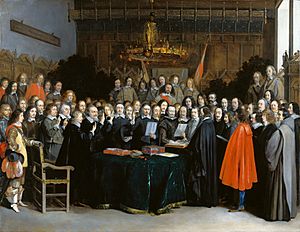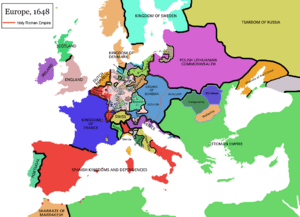Peace of Münster facts for kids
The Peace of Münster was an important treaty signed on January 30, 1648. It was an agreement between the Dutch Republic (called the Lords States General of the United Netherlands) and Spain. This treaty was a huge moment for Dutch history. It officially recognized the Netherlands as an independent country. The Peace of Münster was also a part of the larger Peace of Westphalia. This bigger peace agreement helped end two major wars: the Thirty Years' War and the Eighty Years' War.
Contents
The Dutch Fight for Freedom
The Dutch Revolt (1568–1648) was a long fight. The northern provinces of the Netherlands wanted to be free from Spain. Spain was very powerful at that time. At first, Spain stopped the rebellion. But in 1572, Dutch rebels captured the important port of Brielle. This helped them quickly take control of more areas.
Other countries like France, England, and Scotland supported the Dutch. By 1581, the northern parts of the Netherlands were mostly independent. By the mid-1600s, the Netherlands became a world leader in trade and shipping. This time of great economic, scientific, and cultural growth is known as the Dutch Golden Age.
Why the War Continued
Even with their success, the Dutch could not push Spain out of the rich southern provinces. These areas are now parts of Belgium, Luxembourg, and northern France. France had helped the Dutch for many years. They wanted to make the Habsburg family, who ruled Spain and the Holy Roman Empire, weaker.
In 1635, France officially declared war on Spain and the Holy Roman Empire. This made the conflict even bigger. In 1639, the Dutch navy destroyed a Spanish fleet. This fleet was carrying supplies and soldiers to the Netherlands. This happened at the Battle of the Downs. Then, in 1643, the French defeated a Spanish army at the Battle of Rocroi.
Pushing for Peace
France's involvement and the high cost of the war made Spain change its plans. Spain started to focus on a rebellion in Catalonia, supported by France. After the Battle of Rocroi, France gained a lot of land in the Southern Netherlands. Dutch leaders became worried that France was benefiting too much from the war.
There were even talks of a treaty between Spain and France. This treaty might include a marriage between the French King Louis XIV and a daughter of the Spanish King Philip IV. The Dutch feared this. If it happened, France could claim rights over the Southern Netherlands, and maybe even the northern provinces. These worries made both sides want to end the war quickly.
Making Peace Happen
Peace talks started in 1641. They took place in the German towns of Münster and Osnabrück. As soon as talks began, Dutch trade with the Middle East and Spain grew. Dutch merchants had cheap shipping and no more fighting. They quickly took over markets that English traders used to control. The English Civil War also helped Dutch merchants gain more trade in American colonies.
Spain did not officially call the Netherlands a "Republic" at first. But they agreed that the Dutch government (the Lords States General) was "sovereign." This meant the Dutch could join the peace talks as an equal. In January 1646, eight Dutch representatives arrived in Münster. Two were from Holland, and one from each of the other six provinces.
The Spanish King Philip IV really wanted peace. He gave his envoys (representatives) a lot of power. On January 30, 1648, both sides agreed on the treaty text. It was sent to The Hague (in the Netherlands) and Madrid (in Spain) for final approval. The Spanish and Dutch groups officially approved it on May 15. The Dutch government narrowly approved it on June 5, 1648.
The Wider Peace of Westphalia
The Peace of Münster was part of a bigger set of treaties. These were known as the Peace of Westphalia. This included the Peace of Münster (between the Holy Roman Emperor, France, and their allies) and the Treaty of Osnabrück (between the Holy Roman Empire, Sweden, and their allies). These treaties were signed on October 24, 1648.
Even though conflicts continued in Europe, these treaties were a big step. They changed how countries were seen. Before, power was often linked to individuals, like the Habsburg family. After, it shifted to the idea of independent states.
Challenges After the Treaty
Even after gaining independence, some people in the Dutch government did not like the treaty. They were unhappy that Spain kept the Southern Provinces. They also disliked that the treaty allowed Catholics to practice their religion freely. The powerful province of Holland supported the treaty, so it was approved. But these disagreements led to political problems later on.
An original copy of the treaty is kept in the Rijksarchief (Dutch national archives) in The Hague.
Images for kids
-
Archives of the peace treaty of Münster with the signatures and personal seals of the negotiators, in the National Archives in The Hague. The treaty is about forty pages in total.
See also
 In Spanish: Tratado de Münster para niños
In Spanish: Tratado de Münster para niños





